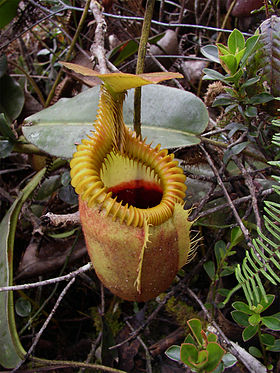- Nepenthes villosa
-
Nepenthes villosa

captador superior de Nepenthes villosa, Monte KinabaluEstado de conservación 
Vulnerable (UICN 2.3)Clasificación científica Reino: Plantae División: Magnoliophyta (sin clasif.): Eudicots Clase: Magnoliopsida (sin clasif.): Eudicots núcleo Orden: Caryophyllales Familia: Nepenthaceae Género: Nepenthes Especie: N. villosa Nombre binomial Nepenthes villosa
Hook.f. (1852)Sinonimia - Nepenthes villosa
auct. non Hook.f.: Hook. (1858)
[=N. veitchii/N. villosa] - Nepenthes villosa
auct. non Hook.f.: G.Cheers (1992)
[=N. × kinabaluensis]
Nepenthes villosa es una planta carnívora[1] tropical endémica del Monte Kinabalu y cercanías del Monte de Tambuyukon, en el noreste de Borneo. Crece a mayor altitud que cualquier otra especie de Nepenthes de Borneo, en elevaciones de más de 3200 msnm. N. villosa se caracteriza por su peristoma desarrollado e intrincado, que lo distingue de N. edwardsiana[2] , estrechamente relacionada, y de N. macrophylla.[3]
El epíteto específico villosa es del latín, para "peludo" y se refiere al denso indumentum de la especie.[4]
Notas
I. ↑ Hooker's description of N. villosa from 1859 reads:[4]
II. ↑ The Latin diagnosis for N. villosa from Danser's monograph reads:[2]- Ascidia magna, ore lamellis latis disciformibus annularibus remotis instructo.
- Nepenthes Villosa, H. f. (Hook, Ic. Pl. t. 888).
- Hab.—Borneo (Lobb), Kina Balu, alt. 8,000–9,000 feet (Low).
Folia mediocria petiolata, lamina obovato-oblonga v. lanceolata, nervis longitudinalibus utrinque 2-3, vagina caulem fere totum amplectente; ascidia rosularum ignota; ascidia inferiora magna, breviter ovata, costis 2 ad os alatis fimbriatis; peristomio operculum versus in collum elongato 6-12 mm lato, costis altis 3-12 mm distantibus, dentibus 1-3 x longioribus quam latis; operculo rotundato-cordato v. paulum reniformi, facie inferiore plano; ascidia superiora magna, parte inferiore ventricosa os versus cylindrica, costis 2 prominentibus; peristomio operculum versus in collum elevato, 12-22 mm lato, costis altis 3-12 mm distantibus, dentibus 1-3 x longioribus quam latis; operculo rotundato-ovato v. paulum reniformi, facie inferiore plano; inflorescentia racemus pedicellis inferioribus 12 mm longis omnibus 1-floris; indumentum villosum.
Referencias
- ↑ Clarke, C.M. 1997. Nepenthes of Borneo. Natural History Publications (Borneo), Kota Kinabalu.
- ↑ a b Danser, B.H. 1928. The Nepenthaceae of the Netherlands Indies. Bulletin du Jardin Botanique de Buitenzorg, Série III, 9(3–4): 249–438.
- ↑ Phillipps, A. & A. Lamb 1996. Pitcher-Plants of Borneo. Natural History Publications (Borneo), Kota Kinabalu.
- ↑ a b Hooker, J.D. 1859. On the origin and the development of the pitchers of Nepenthes, with an account of some new Bornean plants of that genus. The Transactions of the Linnean Society of London 22: 415–424.
- Beaman, J.H. & C. Anderson 2004. The Plants of Mount Kinabalu: 5. Dicotyledon Families Magnoliaceae to Winteraceae. Natural History Publications (Borneo), Kota Kinabalu
- Clarke, C.M. 2006. Introduction. In: Danser, B.H. The Nepenthaceae of the Netherlands Indies. Natural History Publications (Borneo), Kota Kinabalu. pp. 1–15
- Denton, B. 2001. Mt. Kinabalu - much more than Nepenthes Utopia. Bulletin of the Australian Carnivorous Plant Society 20(3): 1–4
- Sacilotto, R. 2004. Experiments with Highland Nepenthes seedlings: A Summary of Measured Tolerances. Carnivorous Plant Newsletter 33(1): 26–31
- Shafer, J. 2003. A Novel Method for the Cultivation of Nepenthes villosa.PDF Carnivorous Plant Newsletter 32(1): 20–23
- Thorogood, C. 2010. The Malaysian Nepenthes: Evolutionary and Taxonomic Perspectives. Nova Science Publishers, New York
Enlaces externos
 Wikimedia Commons alberga contenido multimedia sobre Nepenthes villosaCommons.
Wikimedia Commons alberga contenido multimedia sobre Nepenthes villosaCommons.- Danser, B.H. 1928. 51. Nepenthes villosa HOOK. F. In: The Nepenthaceae of the Netherlands Indies. Bulletin du Jardin Botanique de Buitenzorg, Série III, 9(3–4): 249–438
- Nepenthes villosa
Wikimedia foundation. 2010.
